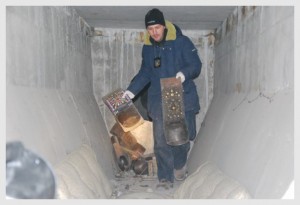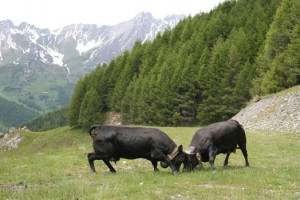 In Valle d’Aosta, the smallest and least populous region of Italy just on the other side of the French Alps, cowbells have achieved cult status with collectors. One of those collectors had a fever … and the only prescription … was more cowbell. So he hired three men to stalk a 90-year-old widow for a week, then at dawn on February 8th they invaded her home in the town of Gressan when she came back from her morning constitutional. They bound Cornelia Betral’s wrists and ankles, gagged her, hooded her and laid her out on her bed while they broke into a locked room where she kept a collection of ten vintage cowbells with elaborately decorated leather collars worth an estimated 20,000 euros (ca. $26,500).
In Valle d’Aosta, the smallest and least populous region of Italy just on the other side of the French Alps, cowbells have achieved cult status with collectors. One of those collectors had a fever … and the only prescription … was more cowbell. So he hired three men to stalk a 90-year-old widow for a week, then at dawn on February 8th they invaded her home in the town of Gressan when she came back from her morning constitutional. They bound Cornelia Betral’s wrists and ankles, gagged her, hooded her and laid her out on her bed while they broke into a locked room where she kept a collection of ten vintage cowbells with elaborately decorated leather collars worth an estimated 20,000 euros (ca. $26,500).
They got away with their euphonious booty, but not for long. Police received tips from the tightly knit cattle breeders community that this theft had been commissioned by 66-year-old Renato Quendoz, a local cattleman and avid cowbell aficionado. On Saturday, February 18th, police arrested Quendoz and two of the hired thieves, Salvatore Agostino (52) and Corrado Daudry (60). A third suspect, thought to be a Romanian citizen, is still at large. The cowbells were found unharmed, stashed in a hidey-hole under a highway overpass just on the other side of town. They will be returned to Mrs. Betral.
Because we live in a great age, the recovery of the cowbells by Aosta CSI was recorded.
[youtube=http://www.youtube.com/watch?v=J-Ak2Cr0O4k&w=430]
You can tell that those are not just any old cowbell. They’re huge, for one thing, and those thick bedazzled collars are rare and valuable. They were made in the capital of old school cowbell manufacture: the Alpine town of Chamonix on the French side of the Mont Blanc Pass. (The Devouassoud family have been making cowbells and church bells the traditional way since 1829.)
Cornelia Betral was left the cowbells by her husband, a cattle breeder who had won them all as trophies in the yearly Batailles de Reines. Here’s where the cowbell entry gets even cooler than you imagined possible, and I know you imagined a lot.
The human population of the Aosta valley as of last year was 128,000. The last time they counted in 2000, there were 40,000 head of dairy cattle, which means one cow for every three people. These aren’t your garden variety Holstein cows. There are several breeds of cows that have been in the area since at least the Romans, and possibly as early as the Neolithic, and living in the Alps makes for one sturdy cow.
According to tradition, the Valdostane breed of cattle was introduced by the Burgundians when they controlled the area in the 5th century A.D. Hardy, agile, scrappy and quick to temper, Valdostanes took to the challenging mountain topography and climate (because of its positioning, the Aosta valley is considerably colder than other populated Alpine regions) like ducks to water. In the summer they go mountain climbing to graze on fresh grasses and local herbs in the high Alps. Their milk is the exclusive source of regional Aostan heritage cheeses like Fontina, the perfect melter, and Robiola, creamy, spreadable deliciousness.
 Because of the advantages conferred by their tough characters in this tough environment, Valdostane cattle retain a fascinating connection to their primal nature. Every Spring, the females fight each other for a spot in the herd hierarchy. Watching the dominance displays has been a spectator sport since at least the 19th century, and probably for millennia. The gatherings were banned by Mussolini in 1926 as part of his campaign to stamp out regional differences. At the same time he was seeding the Aosta valley with Italian speakers to muscle out the local Francophone dialect and culture.
Because of the advantages conferred by their tough characters in this tough environment, Valdostane cattle retain a fascinating connection to their primal nature. Every Spring, the females fight each other for a spot in the herd hierarchy. Watching the dominance displays has been a spectator sport since at least the 19th century, and probably for millennia. The gatherings were banned by Mussolini in 1926 as part of his campaign to stamp out regional differences. At the same time he was seeding the Aosta valley with Italian speakers to muscle out the local Francophone dialect and culture.
As soon as the war was over, local organizations started the Queen battles again on an informal basis. In 1957 they made it official and created the Batailles de Reines (the Battles of Queens) as we know it today, a cruelty-free tournament over the course of months wherein the greatest ladycows wearing the greatest bells throw down for lowing rights. Nobody gets gored, nobody gets stabbed, nobody gets ridden, nobody gets hogtied. The cows lock horns (their sharp points have been filed down) and push against each other until one gives, Sumo style. The loser just trots off and the winner hangs out a bit before her owner comes over with a lead and she meekly walks off the field with him. Ornery though they are, they are still dairy cows, after all.
[youtube=http://youtu.be/ZHu6CNOlw3g&w=430]
Mr. Betral’s cows won ten of these battles, which is how he got those special bells and why they’re so rare and sought-after that a collector would treat a 90-year-old woman far worse than he would ever treat his cows just to get his hands on them.
Burgundians in the 5th century BC?
Gah, no! Good catch, thank you. I’ve corrected it in the post. :thanks:
Wow, never, ever would have known anything about collectible cowbells, but for The History Blog. Awesome story. Thank you, once again!
What a hoot. Notice that the cops had to go through the bridge abutment “bedroom” (check out the mattresses on the floor of the first cavity) to get to the “closet” nook deeper within the structure. Thanks for introducing your readers to yet another topic–this time with lots of laughs.
Everything that I ever wanted to know about Valdostan cows and cowbells but was afraid to ask! But no comment on the Roma football graffiti (ASR = Associazione Sportiva Roma) all over the cowbell bunker?
I hadn’t even noticed that! I was too intoxicated by the closeups of the Official Silver Briefcase of the Science Police.
euphonious booty
Band name!!
I’m picturing a barbershop quartet that does a capella covers of Parliament Funkadelic.
I have a Swiss Devouassoud Chamonix cow bell, it
is a vintage one, 75mm by 80mm and I would
like to know its value.